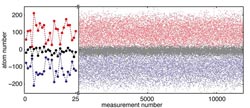Heidelberg Researchers Create “Squeezed” Quantum Vacuum Filled with Atoms

Typically noise is unwanted in experiments, and the challenge is minimising it. In the experiment of generating and detecting a „squeezed“ vacuum, the noise is the signal that reveals the existence of quantum entanglement. Even though the number of atoms in both gases (marked in red and blue) fluctuates extremely, their difference (marked in black) is very small. In order to obtain a correct analysis, a few experiments (on the left) are not sufficient. The noise has to be analysed in long series of measurements (on the right). Figure: Kirchhoff Institute for Physics<br>
Quantum theory is known for its peculiar concepts that appear to contradict the fundamental principles of traditional physics. Researchers from Heidelberg University have now succeeded in creating a special quantum state between two mesoscopic gases with approximately 500 atoms.
The state is known as a “squeezed“ vacuum, in which measuring one gas affects the results of the measurement on the other. To produce these results the team, headed by Prof. Dr. Markus Oberthaler at the Kirchhoff Institute for Physics, had to develop a novel detection technique to measure values in atomic gases that were previously unobtainable. The results of their research have been published in the journal “Nature”.
The quantum state observed by the Heidelberg researchers has been of fundamental interest since it was first put forward in 1935 by Einstein, Podolsky and Rosen (EPR) in a thought experiment. The three researchers wanted to use it to demonstrate that quantum mechanics is not consistent with a local reality of physical systems that is experimentally observable. The EPR situation refers to two systems in a state of quantum entanglement, where measuring one system instantaneously effects the results of the measurement on the other – an incomprehensible fact to our traditional way of thinking, where physical laws exist regardless of whether systems are observed or not.
The breakthrough in the quantum state discovered and created by Prof. Oberthaler and his team lies in the quantum entanglement of continuous variables. This means that in principle, individual measurements of the two gases randomly produce many different values. After measuring one gas, however, all the other measurements on the second – entangled – gas can be precisely predicted. To create and detect a “squeezed” quantum vacuum with its unique characteristics in the laboratory, the researchers worked with a Bose Einstein condensate. This condensate is an extreme aggregate state of a system of indistinguishable particles, most of which are in the same quantum mechanical state. The condensate used was comprised of Rubidium atoms cooled to an ultracold temperature of 0.000 000 1 Kelvin above absolute zero.
“The setup of the experiment had to be extraordinarily stable since we took measurements continuously for many days in a row to gather enough data to verify the generation of a quantum entanglement”, explains Prof. Oberthaler. For this purpose, the researchers had to guarantee the stability of magnetic fields that is 10,000 times smaller than of the magnetic field of the earth. They also needed to detect a gas consisting of 500 atoms with an error tolerance of less than eight atoms since the particle number fluctuations served as the signal for a successful generation of an entanglement. Prof. Oberthaler: “Normally you don’t want noise in experiments, but in our investigations careful examination of the noise actually proved the presence of the quantum entanglement.” The challenge for the Heidelberg team was suppressing the technical noise enough to allow the quantum noise to dominate.
Prof. Oberthaler and his colleagues hope not only that their research results lead to an application for precise atomic interferometry, but also see their findings as an important step in the investigation of fundamental questions of quantum mechanical entanglement of massive particles.
For information online, see http://www.kip.uni-heidelberg.de/matterwaveoptics.
Original publication:
C. Gross, H. Strobel, E. Nicklas, T. Zibold, N. Bar-Gill, G. Kurizki and M.K. Oberthaler: Atomic homodyne detection of continuous-variable entangled twin-atom states. Nature online, 30 November 2011, doi: 10.1038/nature10654
Contact:
Prof. Dr. Markus Oberthaler
Kirchhoff Institute for Physics
Phone: +49 6221 54-5170
markus.oberthaler@kip.uni-heidelberg.de
Communications and Marketing
Press Office, phone: +49 6221 54-2311
presse@rektorat.uni-heidelberg.de
Media Contact
More Information:
http://www.kip.uni-heidelberg.de/matterwaveopticsAll latest news from the category: Physics and Astronomy
This area deals with the fundamental laws and building blocks of nature and how they interact, the properties and the behavior of matter, and research into space and time and their structures.
innovations-report provides in-depth reports and articles on subjects such as astrophysics, laser technologies, nuclear, quantum, particle and solid-state physics, nanotechnologies, planetary research and findings (Mars, Venus) and developments related to the Hubble Telescope.
Newest articles

Superradiant atoms could push the boundaries of how precisely time can be measured
Superradiant atoms can help us measure time more precisely than ever. In a new study, researchers from the University of Copenhagen present a new method for measuring the time interval,…

Ion thermoelectric conversion devices for near room temperature
The electrode sheet of the thermoelectric device consists of ionic hydrogel, which is sandwiched between the electrodes to form, and the Prussian blue on the electrode undergoes a redox reaction…

Zap Energy achieves 37-million-degree temperatures in a compact device
New publication reports record electron temperatures for a small-scale, sheared-flow-stabilized Z-pinch fusion device. In the nine decades since humans first produced fusion reactions, only a few fusion technologies have demonstrated…





















